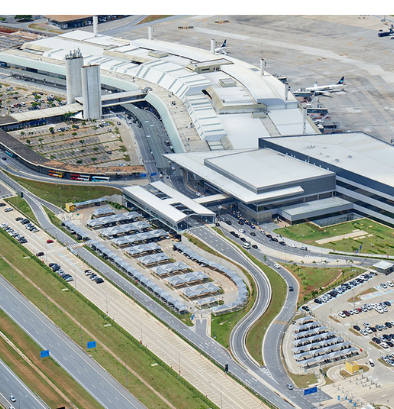-
- Miramar Plaza
- 954 Avenida Ponce de Leon
- Office 201A
- San Juan, Puerto Rico 00907
- + 1 (787) 721 3953
Minas Gerais is known for its culture, history, and indescribable cuisine. One of the main point of entry to Minas Gerais is Belo Horizonte International Airport, located in the municipality of Confins. The airport is home to one of the busiest terminals in the country. In 2013, to prepare for the 2014 FIFA World Cup Brazil, the federal government held an auction to privatize the airport for 30 years. The winner was a consortium formed by the CCR group and Zürich Airport.
The project for the modernization, expansion, and maintenance of Belo Horizonte International Airport aimed to transform the terminal into an “aerotropolis,” offering optimal comfort, safety, and facilities to ensure the best experience for passengers, visitors, and the airport community. To achieve this, the airport needed to improve its connectivity infrastructure, both for internet access and phone calls.
After establishing the goals of the project, QMC Telecom took action. In partnership with ARION, our team brokered the implementation of the project developed by the airport and offered an active multi-operator Distributed Antenna System (DAS) solution. The DAS enabled top speeds in high traffic, increased signal connectivity at the terminal, and 100% coverage of the airport in eight months post implementation.

sectors
The project at Belo Horizonte International Airport was one of the most challenging for the DAS team, as it was QMC’s first case of an indoor solution implemented at an airport. Luckily, the airport already had a Wi-Fi infrastructure; the team expanded the existing connectivity to areas with difficult access that lacked cellular signal from the carriers, such as basements and check-in areas.
The complexity of the area also required thorough detailing of the project. With this in mind, each stage of the project was explored in depth by our team to ensure the highest quality delivery across all phases. This approach by QMC was key to project success and served as a model for future indoor DAS projects.
QMC’s system at the Belo Horizonte International Airport is an Active DAS, a set of network elements that distribute the signal source of cellular operators through Remote Units connected by Optical Fiber. The Active DAS means the signal is closer to the end-user with the exact amount of power transmitted by an infrastructure of more than 200 antennas placed in strategic areas.
The benefits of using DAS at airports include:
“From negotiation to execution, the entire process with QMC was very positive. The company is an excellent partner. The entire team was available to explain to us, in detail, what it would develop in each area. It also conducted the process with complete transparency. We recommend partnering with QMC for indoor connectivity projects”, emphasizes Carlos Marum, Managing Partner of the ARION Group.
“Since developing the project to improve our cellular coverage at the terminal, the goal has always been to offer the best experience to passengers, visitors, and the airport community. The Distributed Antenna System (DAS) brings us toward improving our infrastructure. The world is completely digital, people want and need to be connected, and we’re always aware of trends in the technology market. In this process, we have good partners like QMC who have helped people to communicate well when passing through here, whether on the phone or when needing a quality internet connection,” says Paulo Amarante, Information Technology Manager at BH Airport.